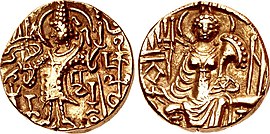|
Kipunada
Kipunada (Brahmi script: Gupta and Kidarite successorsThe coins of Kipunada in Central and Western Punjab were followed by peculiar coins minted locally in Punjab, with the name "Samudra" on them (Gupta script:
Notes
External links
|
|||||||||||||||||||||||||||||||||||||||||||||||||||
Portal di Ensiklopedia Dunia



![Local coin minted in the Punjab area with the name "Samudra" ( Sa-mu-dra, under the king's left arm), presumably Samudragupta, immediately followed those of Kipunada.[6][5]](http://upload.wikimedia.org/wikipedia/commons/thumb/6/65/Samudra_Gandhara_coin%2C_Punjabi_mint_Circa_CE_350-375.jpg/199px-Samudra_Gandhara_coin%2C_Punjabi_mint_Circa_CE_350-375.jpg)
![The next coins were those of Kidarite Hun kings, starting with Kirada ( Ki-ra-da under the king's left arm), who ruled circa 350 CE.[6][5]](http://upload.wikimedia.org/wikipedia/commons/thumb/f/fa/HUNNIC_TRIBES%2C_Kidarites_Kirada_Circa_340-345.jpg/196px-HUNNIC_TRIBES%2C_Kidarites_Kirada_Circa_340-345.jpg)